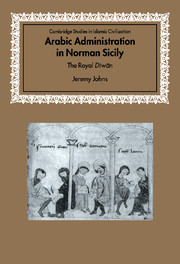Book contents
- Frontmatter
- Contents
- Preface
- Tables
- Abbreviations
- Genealogical table of the De Hautevilles of Sicily
- Note on Measurements
- Introduction
- 1 ‘In the time of the Saracens …’
- 2 ‘When first the Normans crossed into Sicily …’
- 3 ‘Our lady, the Regent Adelaide, and our Lord, the Count Roger, her son’, 1101–30
- 4 The earliest products of the royal dīwān, 1130–43
- 5 The jarāʾid renewed, 1144–5
- 6 The records of the royal dīwān. Part I: the jarāʾid al-rijāl
- 7 The records of the royal dīwān. Part II: the dafātir al-ḥudūd
- 8 The duties and organisation of the royal dīwān, 1141–94
- 9 ‘The people of his state’. The ‘palace Saracens’ and the royal dīwān
- 10 The Norman dīwān and Fāṭimid Egypt
- 11 Royal dīwān and royal image
- Appendix 1 Catalogue of dīwānī documents
- Appendix 2 Provisional catalogue of private documents
- Appendix 3 Abū Tillīs – ‘Old Wheat-sack’
- List of References
- Index
- Titles in the series
11 - Royal dīwān and royal image
Published online by Cambridge University Press: 10 March 2010
- Frontmatter
- Contents
- Preface
- Tables
- Abbreviations
- Genealogical table of the De Hautevilles of Sicily
- Note on Measurements
- Introduction
- 1 ‘In the time of the Saracens …’
- 2 ‘When first the Normans crossed into Sicily …’
- 3 ‘Our lady, the Regent Adelaide, and our Lord, the Count Roger, her son’, 1101–30
- 4 The earliest products of the royal dīwān, 1130–43
- 5 The jarāʾid renewed, 1144–5
- 6 The records of the royal dīwān. Part I: the jarāʾid al-rijāl
- 7 The records of the royal dīwān. Part II: the dafātir al-ḥudūd
- 8 The duties and organisation of the royal dīwān, 1141–94
- 9 ‘The people of his state’. The ‘palace Saracens’ and the royal dīwān
- 10 The Norman dīwān and Fāṭimid Egypt
- 11 Royal dīwān and royal image
- Appendix 1 Catalogue of dīwānī documents
- Appendix 2 Provisional catalogue of private documents
- Appendix 3 Abū Tillīs – ‘Old Wheat-sack’
- List of References
- Index
- Titles in the series
Summary
The kings of Sicily governed a heterogeneous population which Peter of Eboli, referring to the citizens of Palermo and echoing an earlier Latin poet, famously called the populus trilinguis. In the illustration on the folio facing this verse, the three language groups are all clearly depicted, united in mourning the dead King William. Three folios later, a half-page illustration shows King Tancred's chancery at Palermo, with its three adjoining offices of scribes – Greek, Saracen, and Latin – the illustration is reproduced as the frontispiece of this book. These two images both represent the three-tongued people and symbolise the Norman policy of populus trilinguis – that the cohesive rule of the king had united the three communities into a single Sicilian people. That policy of populus trilinguis – its introduction, evolution, partial and temporary successes, and its ultimate failure – lies beyond the scope of this study,4 but it nonetheless underlies this final chapter – and, indeed, much of this book. Here it is sufficient to emphasise that, from the 1150s, if not earlier, until the 1190s, if not later, some Sicilians clearly understood that the peace and prosperity of the island depended upon the acquiescence of the Muslim majority to Christian rule, and upon the ability of the king to keep Christian rule within bounds that could be tolerated by the Muslims. As Ibn al- Athīr put it, on the authority of Ibn Shaddād who had visited Palermo in 1156–7, King Roger ‘treated the Muslims with respect, took them as his companions, and kept the Franks off them, so that they loved him’.
- Type
- Chapter
- Information
- Arabic Administration in Norman SicilyThe Royal Diwan, pp. 284 - 300Publisher: Cambridge University PressPrint publication year: 2002

